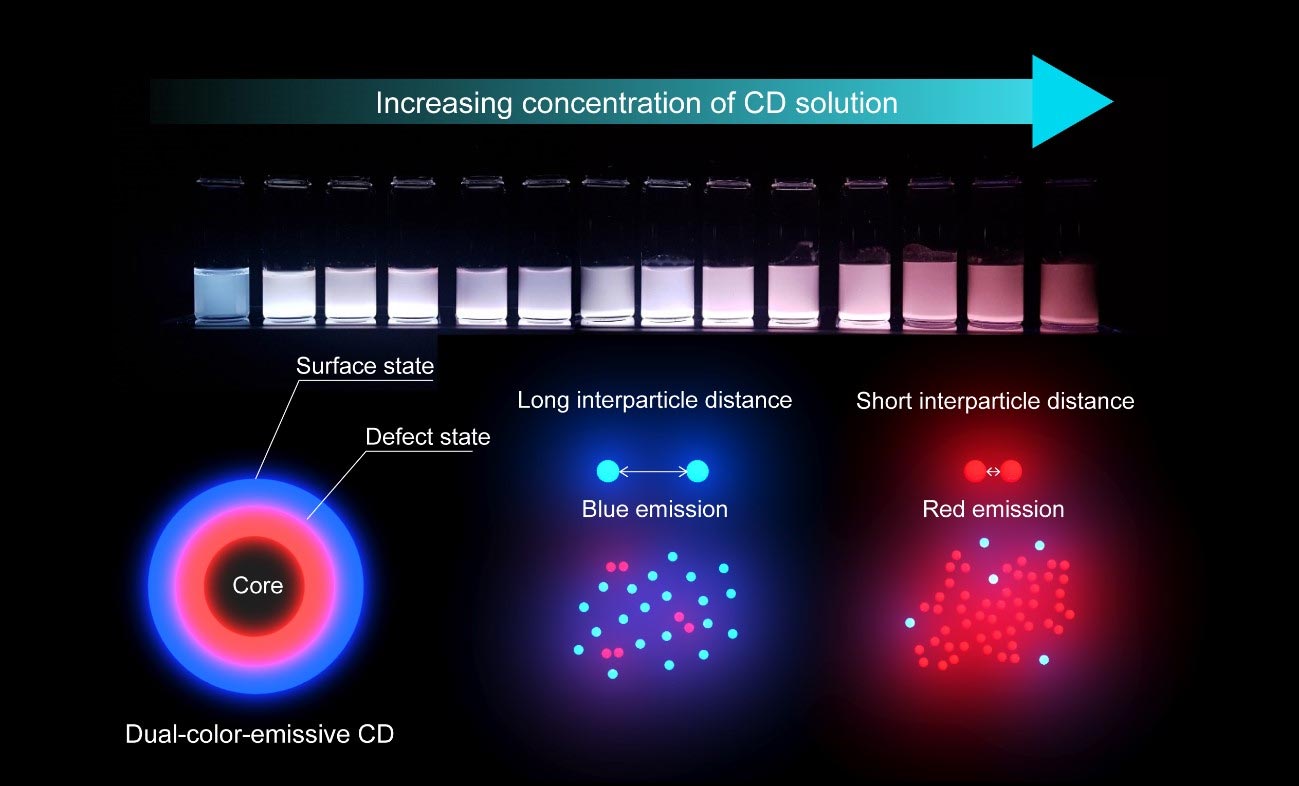Change in photoluminescence of two-color emitting carbon points (CDs) as a function of their concentration. Blue and red emissions show different contributions with different distances between the particles. Image credit: KAIST
KAIST Researchers have synthesized a collection of nanoparticles known as carbon dots that can emit multiple wavelengths of light from a single particle. In addition, the team discovered that the dispersion of the carbon dots or the distance between particles between the individual dots affects the properties of the light that the carbon dots emit. The discovery will enable researchers to understand how these carbon points can be controlled and new, environmentally conscious display, lighting and sensor technologies developed.
Research into nanoparticles that can emit light, such as quantum dots, has been an active area of interest for the past decade and a half. These particles or phosphors are nanoparticles made of different materials that can emit light at certain wavelengths by using the quantum mechanical properties of the materials. This opens up new opportunities for developing lighting and display solutions, as well as more accurate recognition and detection of instruments.
As technology becomes smaller and more sophisticated, the use of fluorescent nanoparticles in many applications has increased dramatically due to the purity of the colors emitted by the dots and their tunability to meet the desired optical properties.
Carbon dots, a type of fluorescent nanoparticle, have seen increasing interest among researchers as a candidate to replace non-carbon dots, the construction of which requires environmentally toxic heavy metals. Since they are primarily composed of carbon, their low toxicity coupled with the tunability of their inherent optical properties is an extremely attractive property.
Another notable feature of carbon dots is their ability to emit multiple wavelengths of light from a single nanoparticle. This multi-wavelength emission can be stimulated under a single excitation source, which enables the simple and robust generation of white light from a single particle by the simultaneous emission of several wavelengths.
Carbon dots also show concentration-dependent photoluminescence. In other words, the distance between individual carbon points influences the light that the carbon points then emit under an excitation source. These combined properties make carbon points a unique source that results in extremely accurate detection and detection.
However, this concentration dependency was not fully understood. In order to fully exploit the capabilities of carbon dots, it is first necessary to uncover the mechanisms that control the apparently variable optical properties. It was previously theorized that the concentration dependency of carbon points is due to a hydrogen bonding effect.
Now a KAIST research team led by Professor Do Hyun Kim from the Department of Chemical and Biomolecular Engineering has postulated and shown that the two-color emissivity is instead due to the particle spacing between the individual carbon points. The research was published in the 36th Problem of Physical chemistry chemical physics.
The first author of the work, PhD student Hyo Jeong Yoo, together with Professor Kim and the researcher Byeong Eun Kwak, investigated how the relative light intensity of the red and blue colors changed when the distances or concentrations of the carbon dots between the particles were varied. They found that the light emitted by the carbon dots would transform when the concentration was adjusted. By varying the concentration, the team was able to control the relative intensity of the colors and simultaneously emit to produce white light from a single source (see illustration).
“The concentration dependence of the photoluminescence of carbon dots on the change in the emission origin for different distances between the particles was overlooked in previous studies. By analyzing the two-color emission phenomenon from carbon dots, we believe that this result offers a new perspective for studying their photoluminescent mechanism, ”explained Yoo.
The newly analyzed ability to control the photoluminescence of carbon dots is likely to be heavily used in the advancement of solid-state lighting applications and sensors.
Reference: “Distance between particles as a key factor in controlling the double emission properties of carbon dots” by Hyo Jeong Yoo, Byeong Eun Kwak and Do Hyun Kim, June 25, 2020, Physical chemistry chemical physics.
DOI: 10.1039 / D0CP02120B



